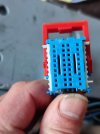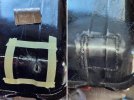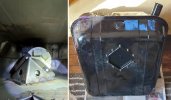Well, I think iI can safely say that I learned a lot more about vehicle wiring than I bargained for.
First the simple problem, on the maiden start of the 1.8 16v engine in the X I had the full Stilo loom in the trunk, plus a battery connected to that (the X’s wiring was not connected).
The engine started and revved, but the instrument panel did not work. After some digging in the pinouts and with the help of the multimeter I found that the instrument panel wasn’t getting ground. Ground is supposed to come through the body computer. Still trying to restore that, but in the mean time wired a ground directly from the pin, so I got to see the revs as well as the error messages (a lot). Most were harmless, others more worrying (like EDB/ASP/ASR/ESP), but the good news was there was no check engine light, which I hope indicates that the smaller Punto HGT catalysts plus secondary generic catalyst did work ok enough to make the O2 sensors read normal operating values.
Then I unpinned (and labeled) all wires of unconnected systems and reconnected the now extremely lean loom:
In the future location of the X:
- The body computer + interior fuse box in the spare wheel space, as well as the batterie connector with the 150 A main fuse (the latter is now getting the power from the stock main and the battery in the stock X location).
- From there three connectors enter the engine bay through the stock cable port in the firewall and connect to the Stilo’s engine bay fuse box, with the main power supply, that also feeds the starter and gets the alternator current:
(Yes I repurposed the old black ground to carry +12V as that was the only proper size wire I had available)
Fiat has nicely packaged the engine management ECU on the intake manifold so the engine bay loom is left as is.
Then when I test started it again and it ran still, ... but I got a check engine light… (and discovered my Mercedes specific ODB2 reader couldn’t connect with the FIAT ODB).
So I went over the whole system to try to find which wire I shouldn’t have unpinned, several times, but found nothing.
Except when I had everything out again I saw that one of the body computer plugs, the only one with a free moving sliding black module (these modern connecters are separate sliding modules all clipped in their connector but this one). Due to too much free room and poor poka/yoke the center part was connected one pin shifted, effectively cutting one of the four remaining circuits on this slider, and mis-connecting the other three.
When I made sure it was in the correct position (the bottom one, difficult to spot the error) the check engine light was off again, Yes! (but it took much time and generated dispare and frustration).
I still have all the kind of worrying error messages on the instrument panel (so the diagnostics is working and there is no reason the ODB port should work either). But I’ve decided that I will trouble-shoot that when I start road testing (after I’ve refurbished engine bay, re-fitted the engine and sorted out the fuel pump and radiator vent + controls and some more).



